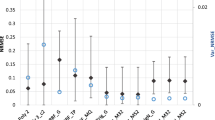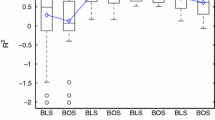Abstract
This research focuses on the study of the relationships between sample data characteristics and metamodel performance considering different types of metamodeling methods. In this work, four types of metamodeling methods, including multivariate polynomial method, radial basis function method, kriging method and Bayesian neural network method, three sample quality merits, including sample size, uniformity and noise, and four performance evaluation measures considering accuracy, confidence, robustness and efficiency, are considered. Different from other comparative studies, quantitative measures, instead of qualitative ones, are used in this research to evaluate the characteristics of the sample data. In addition, the Bayesian neural network method, which is rarely used in metamodeling and has never been considered in comparative studies, is selected in this research as a metamodeling method and compared with other metamodeling methods. A simple guideline is also developed for selecting candidate metamodeling methods based on sample quality merits and performance requirements.






Similar content being viewed by others
References
Bishop CM (1995) Neural networks for pattern recognition. Clarendon, Oxford
Chen S, Cowan CFN, Grant PM (1991) Orthogonal least squares learning algorithm for radial basis function networks. IEEE Trans Neural Netw 2(2):302–309
Chen VCP, Tsui KL, Barton RR, Meckesheimer M (2006) A review on design, modeling and applications of computer experiments. IIE Trans 38(4):273–291
Dyn N, Levin D, Rippa S (1986) Numerical procedures for surface fitting of scattered data by radial basis function. SIAM J Sci Statist Comput 7(1):639–659
Fang KT, Lin DKJ, Winker P, Zhang Y (2000) Uniform design: theory and applications. Technometrics 42(1):237–248
Fang H, Rais-Rohani M, Liu Z, Horstemeyer MF (2005) A comparative study of metamodeling methods for multiobjective crashworthiness optimization. Comput Struct 83(25–26):2121–2136
Fang KT, Li R, Sudjianto A (2006) Design and modeling for computer experiments. Chapman & Hall/CRC, London
Feller W (1968) An introduction to probability theory and its applications, 3rd edn. Wiley, Hoboken
Forrester AIJ, Keane AJ (2009) Recent advances in surrogate-based optimization. Prog Aerosp Sci 45(1–3):50–79
Forsberg J, Nilsson L (2005) On polynomial response surfaces and kriging for use in structural optimization of crashworthiness. Struct Multidisc Optim 29(3):232–243
Giunta A, Watson LT, Koehler J (1998) A comparison of approximation modeling techniques: polynomial versus interpolating models. In: Proceedings of the 7th AIAA/USAF/NASA/ISSMO symposium on multidisciplinary analysis & optimization, No. AIAA-98–4758, St. Louis, MO, 1998
Goel T, Haftka RT, Shyy W, Watson LT (2008) Pitfalls of using a single criterion for selecting experimental designs. Int J Numer Methods Eng 75(2):127–155
Gu L (2001) A comparison of polynomial based regression models in vehicle safety analysis. In: Proceedings of the ASME 2001 design engineering technical conferences and computer and information in engineering conference, Pittsburgh, PA, 2001
Hedayat A, Sloane NJA, Stufken J (1999) Orthogonal arrays: theory and applications. Springer, Heidelberg
Hickernell FJ (1998) A generalized discrepancy and quadrature error bound. Math Comput 67(221):299–322
Hock W, Schittkowski K (1981) Test examples for nonlinear programming codes. Springer, Heidelberg
Hua LK, Wang Y (1981) Applications of number theory to numerical analysis. Springer, Berlin
Ian TN (2004) Netlab: algorithms for pattern recognition. Springer, Heidelberg
Jin R, Chen W, Simpson TW (2001) Comparative studies of metamodelling techniques under multiple modeling criteria. Struct Multidisc Optim 23:1–13
Jin R, Chen W, Sudjianto A (2002) On sequential sampling for global metamodeling in engineering design. In: Proceedings of the ASME 2002 design engineering technical conferences and computer and information in engineering conference, No. DETC2002/DAC-34092, Montreal, Canada, 2002
Kim BS, Lee YB, Choi DH (2009) Comparison study on the accuracy of metamodeling technique for non-convex functions. J Mech Sci Technol 23(4):1175–1181
Kleijnen JPC (1987) Statistical tools for simulation practitioners. Marcel Dekker, New York
Koch PN, Simpson TW, Allen JK, Mistree F (1999) Statistical approximations for multidisciplinary design optimization: the problem of size. J Aircr 36(1):275–286
Koehler JR, Owen A (1996) Computer experiments. In: Ghosh S, Rao CR (eds) Handbook of statistics. Elsevier Science, New York, pp 261–308
Lophaven SN, Nielsen HB, Søndergaard J (2002) DACE—a Matlab kriging toolbox—version 2.0. Technical Report IMMREP-2002-12, Informatics and Mathematical Modelling, Technical University of Denmark, Kgs. Lyngby, Denmark
MacKay DJC (1991) Bayesian methods for adaptive models. Dissertation, California Institute of Technology
Matheron G (1963) Principles of geostatistics. Econ Geol 58(1):1246–1266
McDonald DB, Grantham WJ, Tabor WL, Murphy MJ (2007) Global and local optimization using radial basis function response surface models. Appl Math Model 31(10):2095–2110
Mckay MD, Beckman RJ, Conover WJ (1979) A comparison of three methods for selecting values of input variables from a computer code. Technometrics 21(2):239–245
Montès P (1994) Smoothing noisy data by kriging with nugget effects. In: Laurent PJ, Le Méhauté A, Schumaker LL (eds) Wavelets, images and surface fitting. A.K. Peters, Wellesley, pp 371–378
Mullur AA, Messac A (2006) Metamodeling using extended radial basis functions: a comparative approach. Eng Comput 21(3):203–217
Myers RH, Montgomery DC (1995) Response surface methodology: process and product optimization using designed experiments. Wiley, New York
Paiva RM, Carvalho ARD, Crawford C, Suleman A (2010) Comparison of surrogate models in a multidisciplinary optimization framework for wing design. AIAA J 48(5):995–1006
Papila N, Shyy W, Fitz-Coy N, Haftka RT (1999) Assessment of neural net and polynomial-based techniques for aerodynamic applications. In: Proceedings of the 17th applied aerodynamics conference, No. AIAA 99-3167, Norfolk, VA, 1999
Sacks J, Schiller SB, Welch WJ (1989a) Designs for computer experiments. Technometrics 31(1):41–47
Sacks J, Welch WJ, Mitchell TJ, Wynn HP (1989b) Design and analysis of computer experiments. Stat Sci 4(1):409–435
Simpson TW, Mauery TM, Korte JJ, Mistree F (1998) Comparison of response surface and kriging models for multidisciplinary design optimization. In: Proceedings of the 7th AIAA/USAF/NASA/ISSMO symposium on multidisciplinary analysis & optimization, No. AIAA-98-4755, St. Louis, MO, 1998
Simpson TW, Lin DKJ, Chen W (2001a) Sampling strategies for computer experiments: design and analysis. Int J Reliab Appl 2(3):209–240
Simpson TW, Peplinski J, Koch PN, Allen JK (2001b) Metamodels for computer-based engineering design: survey and recommendations. Eng Comput 17(2):129–150
Simpson TW, Toropov V, Balabanov V, Viana FAC (2008) Design and analysis of computer experiments in multidisciplinary design optimization: a review of how far we have come—or not. In: Proceedings of the 12th AIAA/ISSMO multidisciplinary analysis and optimization conference, No. AIAA 2008–5802, Victoria, Canada, 2008
Stander N, Roux W, Giger M, Redhe M, Fedorova N, Haarhoff J (2004) A comparison of meta-modeling techniques for crashworthiness optimization. In: Proceedings of the 10th AIAA/ISSMO multidisciplinary analysis and optimization conference, No. AIAA-2004-4489, Albany, NY, 2004
Varadarajan S, Chen W, Pelka C (2000) The robust concept exploration method with enhanced model approximation capabilities. Eng Optim 32(3):309–334
Wang GG, Shan S (2007) Review of metamodeling techniques in support of engineering design optimization. J Mech Des 129(1):370–380
Wang L, Beeson D, Wiggs G, Rayasam M (2006) A comparison meta-modeling methods using practical industry requirements. In: Proceedings of the 47th AIAA/ASME/ASCE/AHS/ASC structures, structural dynamics, and materials, No. AIAA 2006-1811, Newport, Rhode Island, 2006
Xiong F, Xiong Y, Chen W, Yang S (2009) Optimizing Latin hypercube design for sequential sampling of computer experiments. Eng Optim 41(8):793–810
Yang RJ, Gu L, Liaw L, Gearhart C, Tho CH, Liu X, Wang BP (2000) Approximations for safety optimization of large systems. In: Proceeding of the 2000 ASME design engineering technical conferences and computers and information in engineering conference, No. DETC-00/DAC-14245, Baltimore, MD, 2000
Zhu P, Zhang Y, Chen GL (2009) Metamodel-based lightweight design of an automotive front-body structure using robust optimization. Proc Instn Mech Eng Part D—J Automobile Eng 223(D9):1133–1147
Acknowledgments
This research is supported by Natural Science and Engineering Research Council (NSERC) of Canada. The use of the Western Canada Research Grid computing services is also acknowledged.
Author information
Authors and Affiliations
Corresponding author
Rights and permissions
About this article
Cite this article
Zhao, D., Xue, D. A comparative study of metamodeling methods considering sample quality merits. Struct Multidisc Optim 42, 923–938 (2010). https://doi.org/10.1007/s00158-010-0529-3
Received:
Revised:
Accepted:
Published:
Issue Date:
DOI: https://doi.org/10.1007/s00158-010-0529-3




